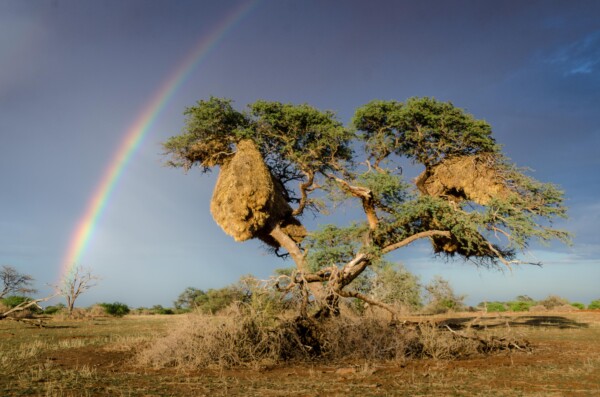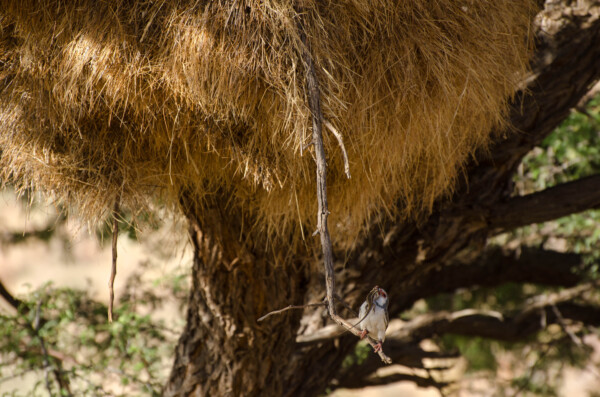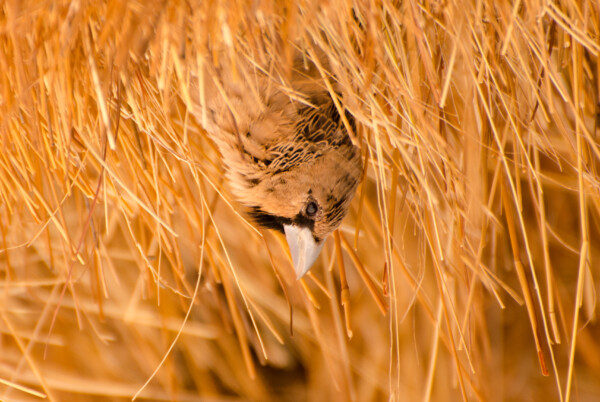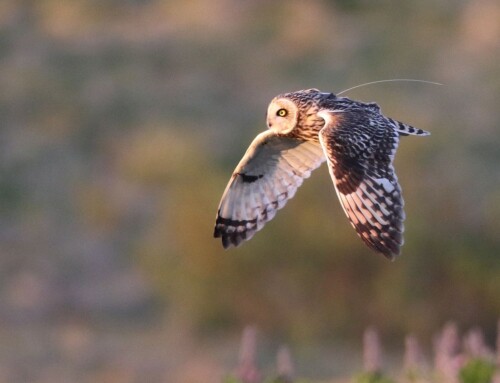
LINKED PAPER
Cost and benefits in extreme nesting associations: do sociable weavers benefit from hosting African pygmy falcons. Lowney, A.M., Thomson, R.L. 2023. IBIS. DOI:10.1111/ibi.13283 VIEW
Sociable Weavers (Philetarius socius) are endemic to Southern Africa. These relatively small birds (15g) build large colonial nesting structures that positively impact local biodiversity, affecting the distribution and behaviour of many species. As a result, that these birds are described as ecosystem engineers (Lowney & Thomson 2021; 2022). The colonies can contain hundreds of individual nesting chambers that provide a refuge against the harsh Kalahari temperatures for the many animals that use them, including Acacia Pied Barbets (Tricholaema leucomelas), Ashy Tits (Melaniparus cinerascens), Scaly-feathered Weavers, (Sporopipes squamifrons), and Rosy-faced Lovebirds (Agapornis roseicollis). The platforms created on top of these structures are used as nesting sites by large birds of prey including Spotted Eagle-owls (Bubo africanus), and tree climbing mammals, such as Small-spotted Genets (Genetta genetta) and Slender Mongooses (Galerella sanguinea), African Wild Cats (Felis lybica), Cheetahs (Acinonyx jubatus) and Leopards (Panthera pardus). The shade created by these colonies are used by large animals including Gemsbok (Oryx gazella) and Greater Kudu (Tragelaphus strepsiceros), while Black-backed Jackals (Lupulella mesomelas) and Cape Porcupines (Hystrix africaeaustralis) often forage below (Lowney & Thomson 2021; 2022; Lowney et al. 2020).

Figure 1. Sociable Weaver colony in a Camelthorn Tree (Vachella eriobola) © Anthony Lowney.
One species that benefits from these structures is the African Pygmy Falcon (Polihierax semitorquatus). This diminutive bird of prey does not build its own nest and in Southern Africa relies solely on weaver colonies for nesting and roosting. This association is so strong that it dictates the distribution of Pygmy Falcons, where there are no weaver colonies there are no Pygmy Falcons. It is unknown whether weavers gain any benefit from this relationship, however Maclean (1970) suggested that falcons may provide defence for colonies by deterring snakes as he did not observe a single snake at colonies that hosted Pygmy Falcons, whereas at colonies without falcons, snakes were frequently recorded. If falcons do deter snakes from colonies, then this could lead to fitness benefits for the weavers as snakes can predate on up to 70% of all weaver breeding attempts (Covas 2002). We wanted to understand whether falcons provide protective benefits to weavers and if so, did it lead to an increase in weaver reproductive success.

Figure 2. African Pygmy Falcon at a Sociable Weaver Colony © Anthony Lowney.
To do this, we undertook observational and experimental approaches. Firstly, we compared snake encounter rates at colonies that hosted falcons to those that did not. Here, we found that the likelihood of encountering a snake more than halved at colonies with falcons, was nearly seven times more likely at colonies when weavers were breeding (independent of whether falcons were breeding or not), and more snakes were seen at the larger colonies.
Due to the decrease in snake encounters at colonies with falcons we wanted to test whether the falcons were actively keeping snakes away. To do this we compared the reactions to a snake stimulus against a control stimulus These were placed at colonies that hosted falcons, while the falcons were breeding. Here we found that falcons did attack the snake stimuli, more than the control. Something we have seen done to live Cape Cobras (Naja nivea) and Boomslangs (Dispholidus typus). We also found that falcons with larger broods acted more aggressively.

Figure 3. Cape Cobra at a Sociable Weaver Colony © Anthony Lowney.
Our results suggest that falcons can defend colonies against snakes, therefore, we expected to find an increase in weaver breeding success at colonies that hosted falcons. Surprisingly, we found was that there was no difference. Falcon and weaver breeding do not always overlap, and it is likely that falcons do not defend the colonies when they are not breeding. We repeated the snake stimuli experiment and confirmed that when falcons were not breeding, the falcons stayed away; there was no reason for the falcons to risk injury. Whereas when falcons were breeding, the adults attempt to provide protection by deterring snakes and preventing their own chicks from being eaten. This suggests that any defensive benefits for the weavers would only occur when the falcons are also breeding. But when we tested this with field data, again we found no difference in weaver nest success when coexisting with falcons. The most plausible explanation is that any defensive benefits that the falcons were providing was offset by the falcons predating on significant numbers of weaver chicks. Interestingly, literature has some anecdotal accounts mentioning that falcons were seen feeding on weaver chicks (Covas 2004). We have witnessed this on several occasions, and wildlife photographers focussing on Sociable Weaver colonies have documented this too. Yet, the Pygmy Falcon predating it’s hosts chicks, was still thought to be infrequent.

Figure 4. Sociable Weaver © Anthony Lowney.
Finally, we wanted to see if the falcons benefited from breeding at the same time as weavers due to additional food in the environment (weaver chicks). We compared the breeding success of falcons when weavers were and were not breeding. We found no difference, but we did find a reduction in the number of falcon breeding attempts that were abandoned due to an apparent lack of resources, but an increase in nest predation (likely snakes) when weavers were breeding. This suggests that there are costs and benefits with breeding at the same time as weavers. There appears to be an increase in food, but consequently an increase in predation. Falcons can defend nests, but it appears that they are not always successful and as a result these two factors may balance each other out.
There appeared to be costs and benefits to both Pygmy Falcons and Sociable Weavers sharing a colony. The falcons gain from not having to build their own nest and are able to feed on weaver chicks at times when weavers are breeding. However, during these times the falcons also suffer from increased nest predation due to other predators being attracted to weaver nestlings. The weavers themselves receive colony defence against snakes, but this is only limited to the times when falcons are breeding and will likely receive increased nest predation by their squatting neighbours. These do suggest high costs to weavers overall, and that the falcons may play an important role in this system particularly as the interplay of costs and benefits may have broader consequences due to the weaver colonies being a crucial ‘resource’ to the Kalahari animal community, especially in hasher areas (Lowney & Thomson 2022). The costs and benefits may vary between seasons, especially in arid environments where resource availability fluctuates between abundant and scarce. In years, of high nest predation pressure by snakes, there may be benefits for weavers to co-inhabit a colony with falcons, because snake visits are destructive and could predate every active nest in the colony (Covas 2002). Falcon populations also fluctuate between years (Bolopo et al. 2019; Olubodun et al. 2023), and an increased number of falcons in a landscape may increase competition for resources, adding to weaver predation pressure. The aspects of costs and benefits to these associates need further investigation and are focus of our future research.
Image credits
Top right: Female African Pygmy Falcon © Anthony Lowney.
Blog posts express the views of the individual author(s) and not those of the BOU.
If you want to write about your research in #theBOUblog, then please see here




